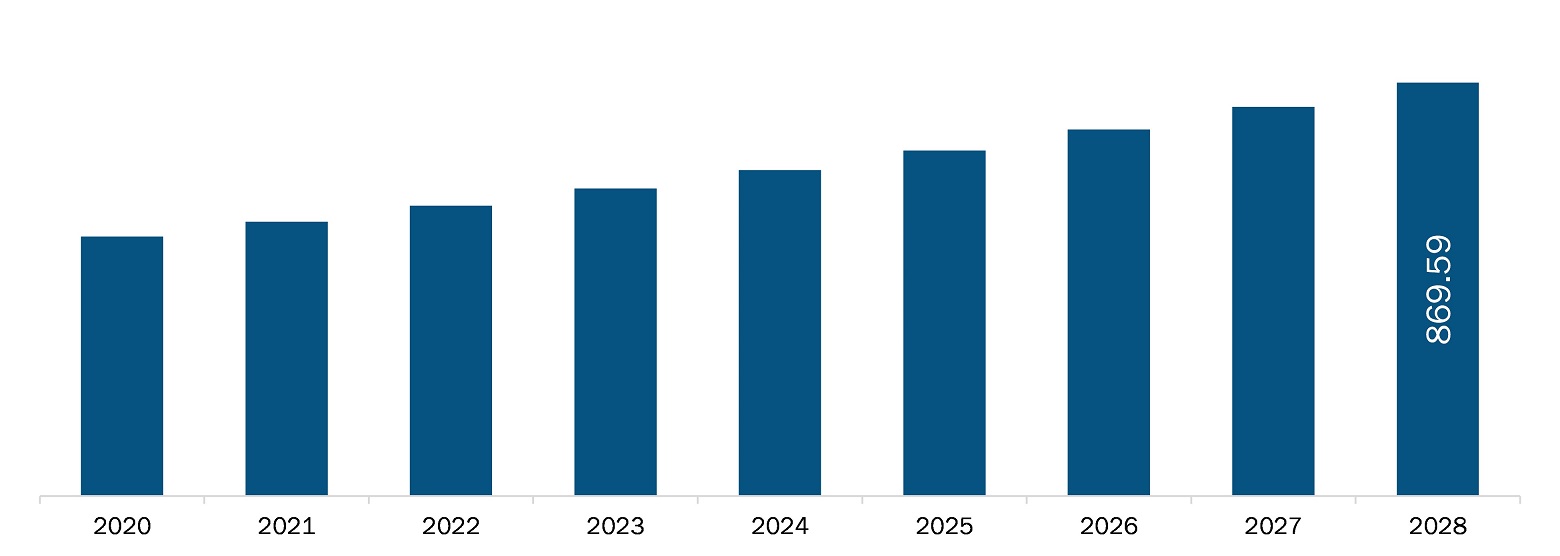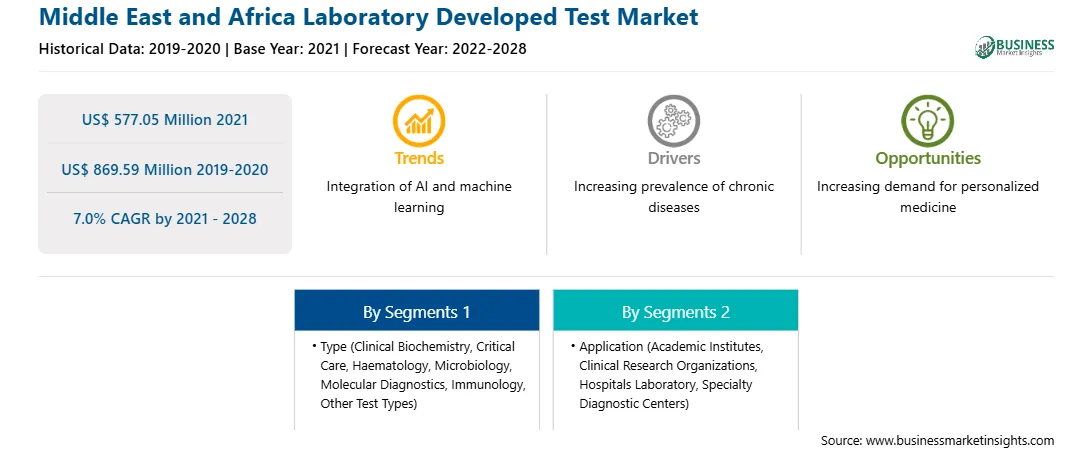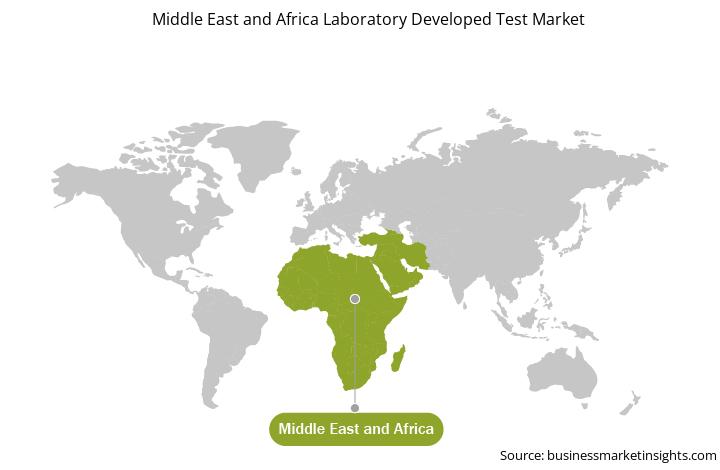A laboratory developed test (LDT) is a type of in vitro diagnostic test that is designed and used within a single laboratory. These tests can be utilized to estimate or distinguish an extensive assortment of analytes materials such as proteins, chemical compounds like glucose or cholesterol, or DNA, from a specimen received from human anatomy. The expansion of automated in vitro diagnostics (IVD) methods for labs and dispensaries to render precise, and error-free analysis is anticipated to fuel the increment.

Strategic insights for the Middle East and Africa Laboratory Developed Test provides data-driven analysis of the industry landscape, including current trends, key players, and regional nuances. These insights offer actionable recommendations, enabling readers to differentiate themselves from competitors by identifying untapped segments or developing unique value propositions. Leveraging data analytics, these insights help industry players anticipate the market shifts, whether investors, manufacturers, or other stakeholders. A future-oriented perspective is essential, helping stakeholders anticipate market shifts and position themselves for long-term success in this dynamic region. Ultimately, effective strategic insights empower readers to make informed decisions that drive profitability and achieve their business objectives within the market.

| Report Attribute | Details |
|---|---|
| Market size in 2021 | US$ 577.05 Million |
| Market Size by 2028 | US$ 869.59 Million |
| Global CAGR (2021 - 2028) | 7.0% |
| Historical Data | 2019-2020 |
| Forecast period | 2022-2028 |
| Segments Covered |
By Type
|
| Regions and Countries Covered | Middle East and Africa
|
| Market leaders and key company profiles |
The geographic scope of the Middle East and Africa Laboratory Developed Test refers to the specific areas in which a business operates and competes. Understanding local distinctions, such as diverse consumer preferences (e.g., demand for specific plug types or battery backup durations), varying economic conditions, and regulatory environments, is crucial for tailoring strategies to specific markets. Businesses can expand their reach by identifying underserved areas or adapting their offerings to meet local demands. A clear market focus allows for more effective resource allocation, targeted marketing campaigns, and better positioning against local competitors, ultimately driving growth in those targeted areas.

The Middle East and Africa laboratory developed test market is expected to reach US$ 869.59 million by 2028 from US$ 577.05 million in 2021; it is estimated to grow at a CAGR of 7.0% from 2021 to 2028. The continuous research on personalized medicine and rising automation of laboratory processes across the globe are factors propelling the laboratory developed testing market. However, the changing regulatory landscape is hampering the growth of the Middle East and Africa laboratory development test market.
LDTs play a vital role in developing personalized medicines that are likely to prove as promising means of tackling diseases through far eluded effective treatments or cures. As per the Personalized Medicine Coalition, personalized medicines accounted for only 5% of the new FDA-approved molecular entities in 2005; however, in 2016, this number rose to more than 25%. Additionally, 42% of all compounds and 73% of oncology compounds in the pipeline have the potential to serve as personalized medicines. Biopharmaceutical companies have nearly doubled their R&D investments in personalized drugs in the last five years across the globe. They are further expected to increase their investments by 33% in the next five years. Biopharmaceutical researchers also predict a 69% increase in the development of personalized medicines in the next five years. Personalized medicines are becoming the trademark of cancer treatment; it is a constantly emerging approach based on the customization of treatments per the individual genetic structure. In 2019, the FDA approved 12 personalized medications to investigate and address the root causes of disease: thus, combining precision medicine in clinical care. The rising demand for personalized medicine is, therefore, offering significant growth opportunities for the players operating in the MEA laboratory developed test market. Also, automation is emerging as an approach to minimize human involvement in laboratory processes boosting market growth.
Economic uncertainties and ongoing conflicts are worsening the condition in the Middle East. For instance, countries such as Syria, Libya, and Yemen are suffering violent conflict and are unable to implement any public health measures. A sudden drop in domestic and external demand for goods and products, especially crude oil, and halted production due to labor shortage are significant impacts observed in the region. Additionally, tightened financial condition is decreasing the economic activities in Middle East. Thus, negatively impacting the growth of the laboratory developed test in the region.
The Middle East and Africa laboratory developed test market, by type, is segmented into clinical biochemistry, critical care, haematology, microbiology, molecular diagnostics, immunology, and other test types. The haematology segment was sub-segmented into coagulation and hemostasis, hemoglobin testing, blood count testing and others. The molecular diagnostics segment held the largest share of the market in 2021. However, the haematology segment is anticipated to register the highest CAGR during the forecast period.
The Middle East and Africa laboratory developed test market, by application, is segmented into academic institutes, clinical research organizations, hospitals laboratory, specialty diagnostic centers, and others. The hospitals laboratory segment held the largest share of the market in 2021. However, the specialty diagnostic centers segment is anticipated to register the highest CAGR during the forecast period.
A few of the primary and secondary sources referred to while preparing the Middle East and Africa laboratory developed test market report are the South Africa Medical Devices Association (SAMED), SA Health Products Regulatory Authority (SAHPRA), and International Agency for Research on Cancer (IARC).
The Middle East and Africa Laboratory Developed Test Market is valued at US$ 577.05 Million in 2021, it is projected to reach US$ 869.59 Million by 2028.
As per our report Middle East and Africa Laboratory Developed Test Market, the market size is valued at US$ 577.05 Million in 2021, projecting it to reach US$ 869.59 Million by 2028. This translates to a CAGR of approximately 7.0% during the forecast period.
The Middle East and Africa Laboratory Developed Test Market report typically cover these key segments-
The historic period, base year, and forecast period can vary slightly depending on the specific market research report. However, for the Middle East and Africa Laboratory Developed Test Market report:
The Middle East and Africa Laboratory Developed Test Market is populated by several key players, each contributing to its growth and innovation. Some of the major players include:
The Middle East and Africa Laboratory Developed Test Market report is valuable for diverse stakeholders, including:
Essentially, anyone involved in or considering involvement in the Middle East and Africa Laboratory Developed Test Market value chain can benefit from the information contained in a comprehensive market report.